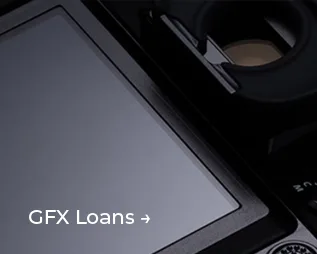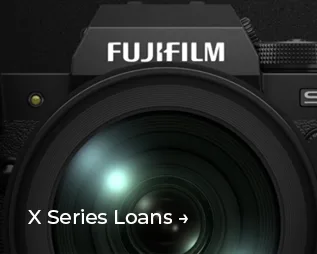Our Photography Specialist, Farhan Khan, recounts his expedition to capture the majestic beauty of the Northern Lights. Read on to see how the FUJIFILM X-T5 helped him create his vibrant Aurora photos.
There's something truly magical about the Arctic night sky, ablaze with the Northern Lights. I stood there in awe on the snow-covered mountains with my Fujifilm camera in hand, ready to capture this surreal spectacle. It was the first time I had crossed the Arctic circle and witnessed the Aurora Borealis. I felt the world pause as the Auroras painted the sky with their ethereal glow.
I had embarked on this journey to Lapland, Finland, with my trusty companion: the FUJIFILM X-T5 Camera, paired with the 8-16mm f/2.8 lens. I used the FUJIFILM House of Photography Try Before You Buy loan system to see how this fantastic equipment stood up to the test.
My photography expedition was more than just a quest for a perfect shot; it was a thrilling adventure that took me beyond my comfort zone.

Planning to shoot the Aurora Borealis
It isn’t just a question of knowing the right gears and camera settings, or just getting lucky — but a lot of pre-production and research work involved. I relied on several Aurora sighting and weather prediction apps.
These apps provided real-time data on aurora forecasts, solar activity, and weather conditions. They became my digital compass, helping me navigate the Arctic wilderness and find those prime spots to set up my tripod and capture the dancing lights. I would say tracking the Northern Lights is akin to chasing a fleeting dream.
Managing the climate
The Arctic cold was unforgiving, but my Fujifilm gear stood the test. Despite the -25℃ temperature, the X-T5 performed flawlessly, maintaining its functionality in the frigid conditions. The 8-16mm f/2.8 lens allowed me to capture the intricacies of the Northern Lights.
The search for the perfect vantage point to capture the Northern Lights was no easy feat. I decided to rent a mountain bike to navigate the snowy terrain. As I peddled through the vast expanse of snow-covered mountains, the thrill of the chase coursed through me. The Aurora Borealis seemed to dance just out of reach, teasing me with its elusive beauty.
But as I ventured deeper into the wilderness, I encountered challenges I hadn't anticipated. The slippery terrain caused my bike to skid and slide, and I found myself losing balance. Despite the falls and the freezing temperatures, my determination never wavered. I was determined to capture the Northern Lights in all their glory.
Photographing the Northern Lights
Finally, after hours of riding and navigating the treacherous terrain, I found it – the perfect spot to set up my gear. As the Northern Lights illuminated the sky above me, I felt a sense of accomplishment and wonder.
The hardships I faced were worth it — for I had captured the essence of the Arctic in each single exposure.
The best settings for Northern Lights photography
If you’re hoping to photograph the Northern Lights yourself, I highly recommend the FUJIFILM X-T5 with an 8-16mm f/2.8 lens or any other fast lens. You can also enjoy a Try Before You Buy camera loan with the FUJIFILM House of Photography to help make sure this model works for you.
For best results, here are the settings I found most effective using the X-T5:
- ISO: Keep it low, around 400-800, to minimise noise.
- Aperture: A wide aperture, such as f/2.8, lets in more light, enhancing the colours of the Aurora Borealis.
- Shutter Speed: Aim for a 10-20 second exposure to avoid star trails.
Northern Lights photography: Dos and Don’ts
I learned the hard way to keep my gear close to my body for warmth, always carry extra batteries, and never rush the process. Patience and preparation are key to capturing the magic of the Northern Lights.
Here are some quick Dos & Don’ts and some tips to tackle the biting cold:
Do:
- Experiment with different compositions, incorporating foreground elements like trees or mountains to add depth to your shots.
- Use a tripod to keep your shots steady, especially in windy conditions.
- Layer up and use hand warmers to keep yourself and your gear warm.
- Carry extra batteries and keep them warm — the cold drains batteries faster.
- Keep your camera moving — in freezing temperatures, its LCD screen might freeze. Motion can help prevent this.
Don't:
- Forget to check your focus. Manually focus to infinity or use autofocus on a bright star to ensure sharp images.
- Overexpose the shots. It's better to slightly underexpose and recover details in post-processing.

The FUJIFILM House of Photography Try Before You Buy loan service
Using photography gear in such extreme conditions was a revelation. All the equipment I used was loaned from the FUJIFILM House of Photography Try Before You Buy service. Here, you can test cameras and equipment out before purchasing it. This service helped me produce extraordinary content with ease and efficiency.
The FUJIFILM X-T5 Camera and 8-16mm f/2.8 Lens delivered exceptional performance and image quality. The camera's weather-sealing and durability surpassed my expectations, ensuring it survived the harsh Arctic conditions. The sharpness and colour rendition of the lens added an extra dimension to my Northern Lights shots, capturing their beauty with stunning clarity.

An Arctic adventure made memorable with Fujifilm
My journey to Lapland was a soul-stirring adventure, filled with memorable moments under the Northern Lights. With my Fujifilm gear by my side, I was able to capture the ethereal beauty of this natural phenomenon, creating images that will forever be etched in my memory.
More than mere tools, the FUJIFILM X-T5 Camera and 8-16mm f/2.8 Lens are companions that enable photographers to capture the magic of the world around them.


















 +44 (0) 203 486 4610
+44 (0) 203 486 4610 8-9 Long Acre, Covent Garden, London, WC2E 9LH
8-9 Long Acre, Covent Garden, London, WC2E 9LH houseofphotography@fujifilm.com
houseofphotography@fujifilm.com




